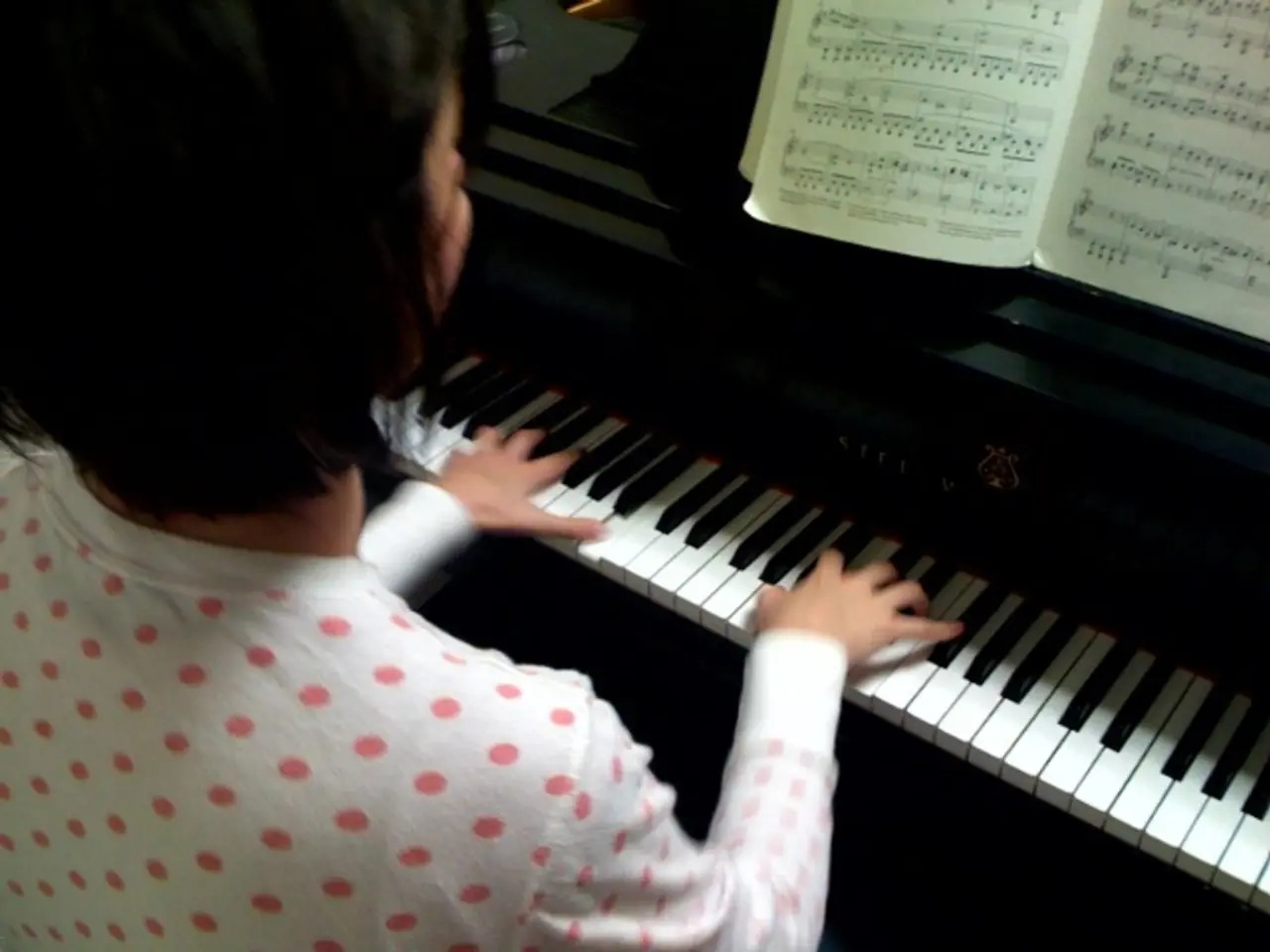Advantages and Disadvantages of Learning Musical Instruments Over the Internet
In the ever-evolving world of music education, two primary methods have emerged as the go-to options for aspiring musicians – online and in-person lessons. Each approach offers unique advantages and challenges, making the choice between the two dependent on the learner's preferences, needs, and environment.
Online orchestration courses have revolutionized the way music enthusiasts learn complex subjects like orchestration. With flexibility and adaptability at their core, online courses allow learners to access materials anytime and anywhere, making it easier to fit learning into diverse schedules. This flexibility supports modular learning and the ability to revisit content as needed, which is particularly useful for complex subjects like orchestration [1].
Online platforms can integrate AI-assisted tools, interactive interfaces, and multimedia resources that facilitate self-paced and personalized learning. These technologies help learners reflect and adjust their strategies actively [3]. The convenience and scalability of online learning also eliminate the need for physical presence, travel, or fixed schedules, allowing broader participation from different geographic locations.
However, online orchestration courses have their disadvantages. The nuanced, collaborative, and highly interpersonal nature of orchestration may suffer without in-person cues and immediate feedback. Some aspects of musicianship and ensemble dynamics are better experienced face-to-face [2]. Online learners often struggle with procrastination and maintaining consistent study routines without the structured environment of in-person classes [3]. Additionally, orchestration involves coordinating live musical ensembles, which requires immediate auditory and visual feedback. In-person lessons offer direct experience in these settings, which is difficult to replicate online, especially regarding nuances like tuning, balance, and real-time adjustments [2].
In-person orchestration lessons provide a richer real-time collaboration and hands-on experience. Conductors and instructors can provide on-the-spot corrections and demonstrations, crucial for mastering complex techniques and ensemble coordination [2]. Being physically present with an orchestra develops a broader awareness and musicianship, as learners must listen and adapt in real time to the group’s dynamics [2]. Scheduled lessons and rehearsals also help maintain discipline and consistency in practice habits.
However, in-person lessons have their disadvantages as well. Fixed class times and locations might be inconvenient and less accommodating for busy or remote students. Geographic and commuting constraints may limit who can participate in high-quality orchestration programs. Transporting instruments for in-person lessons can be tiring and inconvenient, especially for those who don't drive or rely on public transit. Students learning online need a quiet, distraction-free space for their sessions.
In summary, online orchestration courses offer flexibility, resource accessibility, and convenience but may lack the immediacy of feedback and ensemble interaction vital for conducting and musical coordination. In-person lessons provide richer real-time collaboration and hands-on experience but with reduced scheduling flexibility and higher access barriers. Depending on the learner's goals and context, a hybrid model might also combine the best features of both formats.
During flu season or times of heightened contagious illness concern, some families may prefer online lessons for safety reasons. A reliable internet connection is essential for successful online music lessons to avoid glitches, buffering, or audio dropouts. Online platforms make it easy to share sheet music, backing tracks, videos, and notes. Online students must have access to their own instruments and accessories, such as proper seating, music stands, lighting, and any necessary cables or adapters.
In smaller towns or rural areas, students may have limited access to local music teachers who specialize in the instrument, style, or level they are looking for. The cost of online and in-person lessons may vary based on the teacher and format, with some online teachers charging more for preparing materials, organizing digital tools, or recording feedback. On the other hand, online lessons offer wider access to instructors, allowing students to choose a teacher who fits their style, skill level, or specific goals.
In conclusion, the world of music education is evolving rapidly, with online and in-person lessons offering unique advantages and challenges. The choice between the two depends on the learner's goals, context, and preferences. Whether you're a budding musician seeking to master the complexities of orchestration or an experienced composer looking to refine your skills, the options for online music lessons are broader than ever, including piano, voice, guitar, and orchestration courses.
- For individuals interested in learning complex music subjects like orchestration, online courses offer flexibility and access to materials anytime and anywhere, supporting modular learning.
- Online platforms often integrate AI-assisted tools, interactive interfaces, and multimedia resources, facilitating self-paced and personalized learning.
- However, the nuanced nature of orchestration and collaborative ensemble dynamics may suffer without in-person cues and immediate feedback in online courses.
- In-person orchestration lessons provide on-the-spot corrections, demonstrations, and a richer real-time collaboration, crucial for mastering complex techniques and ensemble coordination.
- A hybrid model combining online learning with in-person lessons might be beneficial, capitalizing on the best features of both formats.
- During flu seasons or times of contagion concern, some families might prefer online lessons for safety reasons, requiring a reliable internet connection.
- In smaller towns or rural areas, limited access to local music teachers may push students towards online lessons, offering wider access to instructors who fit their style, skill level, or specific goals.
- Online and in-person lessons can impact one's lifestyle, fashion, food-and-drink, home-and-garden, relationships, pets, travel, car ownership, education, self-development, and shopping habits accordingly.




